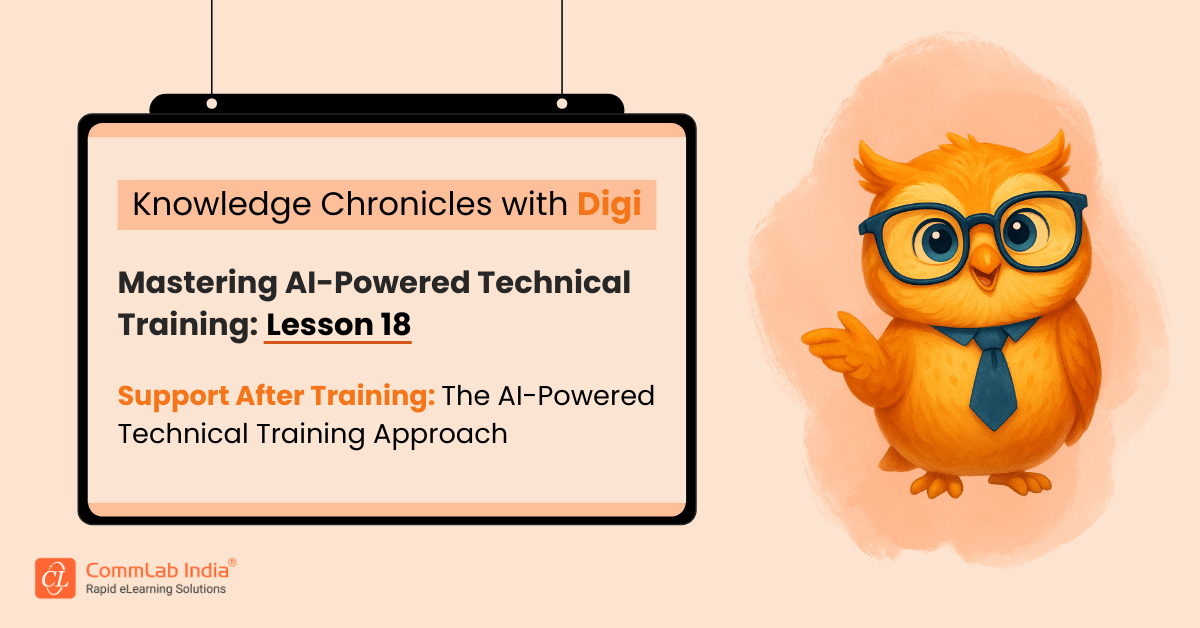
Support After Technical Training: The AI-Powered Approach
Training doesn’t end at the last slide. For sales and service staff, that’s when the real test begins.
They step into customer calls, field service jobs, and live demos—often days or weeks after completing a course. And by then, much of what they learned is already fading. Without ongoing support, reminders, and access to tools in the moment of need, knowledge degrades, confidence dips, and performance suffers.
The solution isn’t more technical training—it’s smarter workflows.
AI-enabled workflows now allow Learning & Development (L&D) teams to embed learning into the day-to-day reality of sales and service teams. These systems don’t just reinforce content. They deliver timely nudges, enable performance support, and capture data to refine future training.
This blog explores how to design post-training AI workflows that drive long-term behavior change and business impact.
Table Of Content
Why Post-Training Support Matters
Research tells us:
- Learners forget up to 70% of new information within a week (Ebbinghaus Forgetting Curve)
- One-time training rarely changes behavior without reinforcement
- Field teams often operate under pressure, where confidence and quick access to the right answer matter more than theoretical knowledge

What AI Workflows Can Do Post-Training
How Does AI Reinforce Technical Training in Daily Work?
The true test of training is what employees do on the job. AI enables timely nudges, quick access to knowledge, and smart coaching that helps teams perform with confidence when it counts.
AI technologies enable seamless, lightweight, and highly contextual support in the flow of work. Here’s how:
1. Spaced Reinforcement and Recall
Platforms like Qstream and MaxLearn use AI to:
- Send personalized quizzes after training
- Space repetition over time to improve retention
- Adapt difficulty based on learner performance
Example: After a course on new troubleshooting protocols, service reps receive microlearning daily via mobile, reinforcing key decisions and steps.
Here’s how the right training fuels both retention and performance.
2. Performance Nudges
AI tools like Spekit, Whatfix, and WalkMe push:
- Contextual tooltips inside CRMs or service platforms
- Process prompts based on recent errors or missed steps
- Real-time job aids at critical moments
Example: A rep logging a support ticket gets a prompt: “Have you verified XYZ before escalating?”
3. Smart Knowledge Access
AI-enhanced knowledge bases (e.g., Notion AI, Guru) allow natural-language search:
- “How do I demo the new pricing calculator?”
- “What’s the checklist for Model ZX install?”
These tools return instant answers, quick videos, or annotated procedures—curated and updated continuously.
4. Chatbot-Based Field Coaching
Conversational AI (e.g., through Microsoft Copilot, Intercom, or custom bots) enables:
- Always-on access to training summaries
- Field-friendly FAQs
- Escalation routing and content suggestions
Example: A sales engineer types, “What’s the difference between Product A and B for enterprise clients?” The bot returns a tailored comparison chart.
5. Data-Driven Coaching
AI connects learning data with CRM/service outcomes. This lets managers:
- Identify reps who need coaching
- See who’s using (or ignoring) support tools
- Trigger refreshers or follow-up scenarios
Example: A field technician scores low on reinforcement questions and logs repeat issues. A refresher video is automatically assigned.

AI-Powered Technical Training – A Practical Guide
- Training formats that work best for technical learners
- 3-touchpoint model for seamless collaboration with SMEs
- Practical tools and templates
- And More!
Case Study: AI Workflow for a Product Launch
A cybersecurity company trained 500+ sales and service staff on a new threat detection product. Instead of ending the engagement at course completion, they:
- Launched a spaced quiz campaign via MaxLearn
- Embedded objection-handling prompts in Salesforce
- Set up a chatbot to answer customer-facing queries
- Created a searchable Notion hub with video demos and QRGs
- Monitored demo win rates and support ticket trends
Results in 8 weeks:
- Product demo confidence scores rose 40%
- New product support tickets dropped by 33%
- 91% of staff rated post-training tools as “critical to success”
How to Build an AI-Powered Post-Training Workflow
1. Define the high-stakes behaviors
What must the learner do (not just know) after technical training?
2. Select reinforcement channels
Email, mobile app, embedded UI prompts, Slack?
3. Curate a minimum viable knowledge base
Use AI to summarize long documents and videos
4. Tag learning to systems
Use CRM fields or support actions to trigger nudges
5. Analyze and adapt
Use data to refine spacing intervals, personalize content, and update job aids
Final Thought
A training module is a spark. But without fuel and follow-through, it fades fast.
Sales and service teams operate in dynamic, high-pressure environments. They need learning that doesn’t just teach—it supports. AI-powered workflows make that possible.
By embedding learning into daily tools, reinforcing knowledge over time, and using real-time data to guide support, L&D leaders can create ecosystems where training never really ends—it evolves.
That’s the difference between a completed course and a confident, capable rep.
And that’s what it means to go beyond the module.




